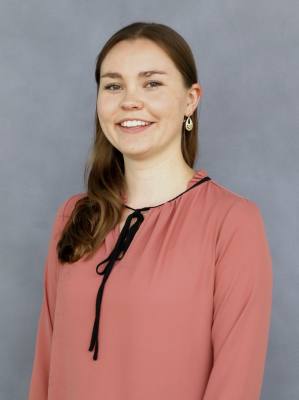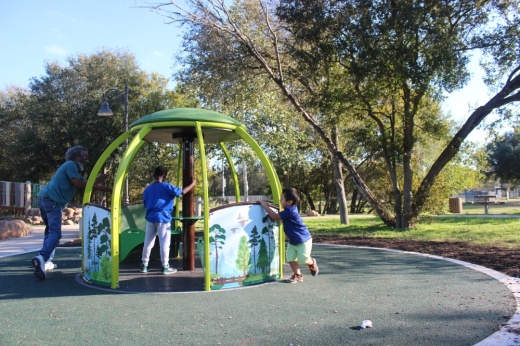Between 1995 and 2017, as Austin’s population climbed from just over 500,000 people to just under 1 million, the ratio of acres per 1,000 residents dropped from 27 to 18, according to city data.
Over the last four years, however, the city has maintained that ratio of 18 acres per 1,000 people by acquiring enough land—548 acres—to keep up with the population.
“Our population is growing so much and [so is] the demand for recreation and the pressure on our central parks,” said Ricardo Soliz, who manages park planning in the Austin Parks and Recreation Department.
Soliz said parkland is important for people’s mental and physical health. He said hitting the city’s goal of 24 acres per 1,000 residents is important to make sure parks are not overcrowded or overused. One way the city funds the park growth is with fees paid by builders. Every time a developer creates new housing, the city requires that they either add parkland or pay a fee.
Although developers have paid such fees for decades, a 2016 change to the city’s parkland dedication ordinance increased parkland dedication fees to more closely reflect the cost of land, Council Member Alison Alter said.
She said the fees have been instrumental to the parkland acquisition strategy.
In October, the city raised the cost of fees by 124% due to land costs, Alter said.
Real Estate Council of Austin members said the city’s fees could lead to more expensive housing.
“Parkland is and always will be incredibly important for our residents, but affordability in this city is at least as important,” RECA Director of Advocacy Alina Carnahan said at an Oct. 21 City Council meeting.
Alter said developers are “trying to decimate” the fee system.
“They’re using this false choice of affordability when it really comes down to, they don’t want to give up some of their profits to help with what makes Austin, Austin,” Alter said.
Why parks matter
On Nov. 2, Jill Haimes explored the newly opened Waterloo Park with her goldendoodle. Haimes moved to Austin two years ago, following her adult children.
“When I go home and people say, ‘How do you like Austin?’ I will always say I love the green space, I love the music,” Haimes said.
Austin’s parks are one of the city’s biggest draws for newcomers, said Heidi Anderson, executive director of the Trail Foundation.
“People have come to visit for whatever reason and they went on [Lady Bird Lake Trail], and that was the deciding moment when they realized they wanted to move,” Anderson said.
Just being able to see green space is associated with greater mental wellbeing, said University of Texas professor Stacy Jorgensen, whose research has examined conservation and public health.
A 2011 study in the American Journal of Epidemiology found that planting greenery in vacant lots in Philadelphia was associated with consistent reductions in gun assaults and vandalism. Residents near lots that had been filled with plants also reported less stress and more exercise than those living near untended vacant lots.
“One of the most important things is literal proximity,” Jorgensen said. “People need park space in their neighborhoods, like a collection of pocket parks.”
Pocket parks—small green spaces in otherwise deficient areas—might have the greatest affect on the city’s overall rates of depression, anxiety and obesity, Jorgensen said.
“Your chances of going outside, going on a walk, go up exponentially if there’s a park close to where you live,” said Colin Wallis, CEO of Austin Parks Foundation.
Developers make their case
RECA CEO Dianne Bangle said the city’s formula for the parkland fee for developers is problematic. She said land prices went up by about 30% in Austin during the last year, while the parkland fees more than doubled.
The city calculates the parkland dedication fee each year based on the amount of dedication fees it has spent on park acres over the last five years.
Excess fees will be passed on to owners and renters with higher prices, Bangle said. Meghan Lash, an affordable housing developer and member of RECA, said at an Oct. 21 City Council meeting, it will hurt complexes with low cost or affordable units the most, as it is already difficult to afford those projects.
Jorgensen said a 2014 study from Landscape and Urban Planning found that while adding green space in urban areas promotes public health, that space can also, “create paradoxical effects such as gentrification.”
“There is this idea that you need to make places just green enough,” Jorgensen said.
Lyons said the price developers pay is actually low by some estimates.
Currently, the fees are based on roughly the cost of $166,000 an acre, Lyons said. She said by one estimate from commercial real estate firm CoStar, the city’s available land is valued at close to $2 million an acre. Outside of parkland purchases, the city averages roughly $870,000 per acre, Lyons said.
Keeping up
While Austin ranks 72nd among the 100 largest U.S. cities in terms of overall percentage of people who live within a half-mile walk of a park, it is quickly improving, per data from Trust for Public Land, a national nonprofit. It ranked 8th for the largest year-over-year increase in access.
Since 2016, the city has used parkland dedication fee dollars to acquire 43 acres of land across 15 parks, according to data from the city.
More than $22 million from developers’ fees is assigned to ongoing park projects. Overall, parkland dedication fees paid for about 8% of parkland acres acquired by the city since 2017, according to the data.
Wallis said the city ultimately needs help from outside funding sources to reach its eventual goal of 24 acres per 1,000 residents.
The city can fund parks through grants from the state, spending approved by voters through bonds, and philanthropy.
Recently, philanthropy funded much of Waterloo Park’s development. The development of Dove Springs District Park and Colony District Park were both funded in part by grants from Texas Parks & Wildlife. Proposition B, approved by Austin voters Nov. 2, will allow the city to offer a trade of 9 acres of land in the Lakeshore area for 48 parkland acres.
Will Klein, project manager for parks research at Trust for Public Land, said increasing access to parks is not necessarily about acquiring as much land as possible, but securing parkland in the right highly-populated areas.
“If we don’t buy them now, you’ll never be able to buy them. The cost of land is so expensive and it’s not going to get cheaper,” Wallis said. “We need to continue to invest in those parks, so when Austin grows to 4 million instead of 2 million people, we’ve land-banked those parks for future generations.”





